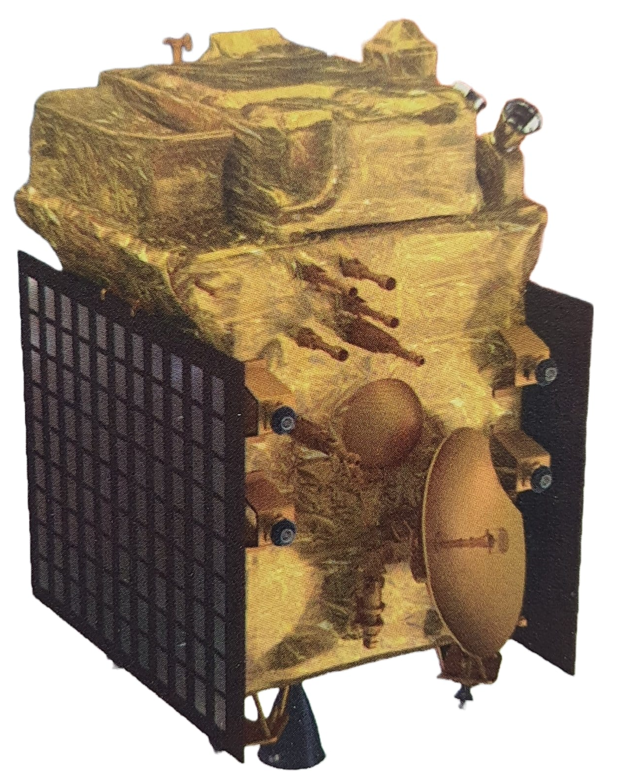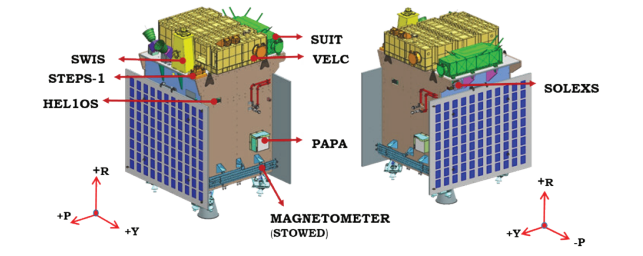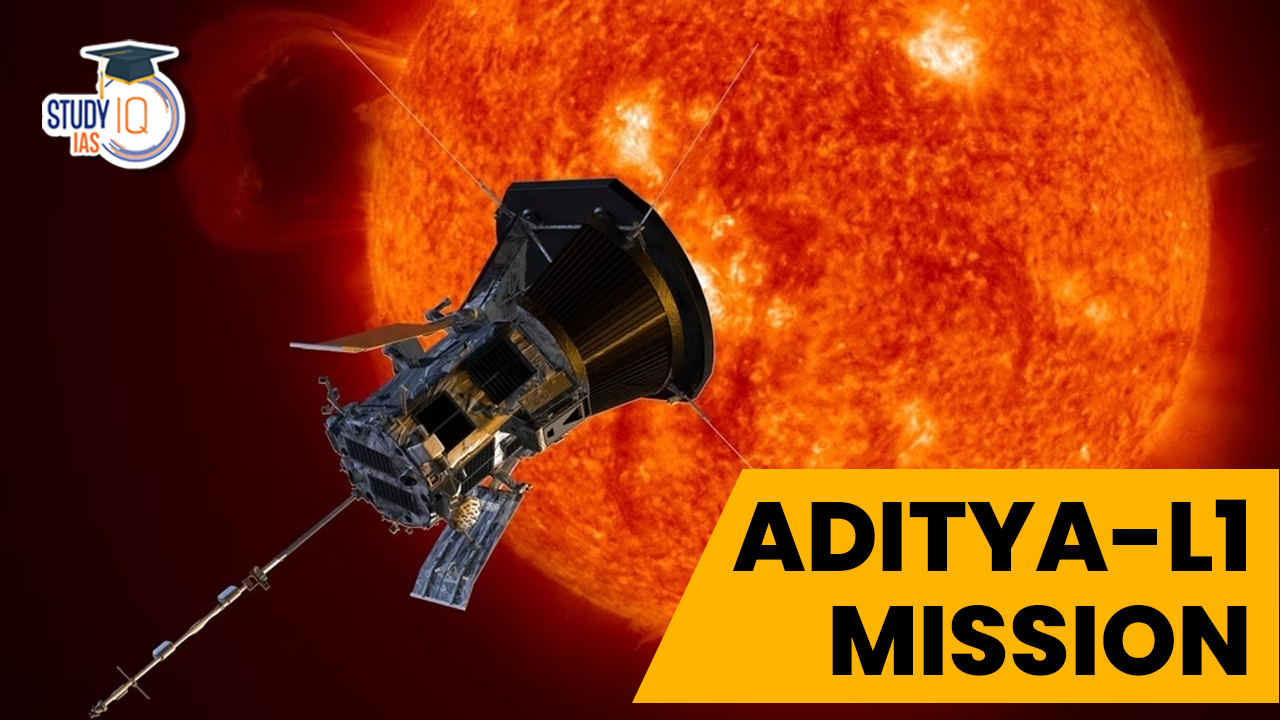Table of Contents
Context: Recently Aditya-L1 (India’s first solar mission) equipped with remote sensing payloads, captured images of the Sun.
More in News
- Images captured by Aditya-L1 reveal the Sun’s dynamic activities including a solar storm that occurred in May.
- Notable solar flares of X-class and M-class erupted in the region AR13664 on the Sun.
- These flares were associated with coronal mass ejections (CMEs).
- Two instruments, the Solar Ultraviolet Imaging Telescope (SUIT) and Visible Emission Line Coronagraph (VELC), were active during this period.
Aditya-L1 Enters Sun’s Final Orbit
ISRO achieved another milestone on January 6, 2024, by successfully executing the last manoeuvre to position the Aditya-L1 spacecraft into its designated orbit, marking India’s accomplishment in deploying its inaugural solar observatory. This observatory, designed to study the Sun, has now reached its final destination approximately 1.5 million kilometres away from Earth. India celebrates the successful establishment of Aditya-L1, reinforcing its capabilities in space exploration.
Aditya L1 Mission
| Date | Event |
| September 02, 2023 | India’s first solar observatory embarks on its journey to the Sun-Earth L1 point. |
| September 03, 2023 | The next manoeuvre is scheduled for September 5, 2023, around 03:00 Hrs. IST. |
| September 05, 2023 | The second Earth-bound manoeuvre was successfully performed, achieving a new orbit of 282 km x 40225 km. |
| September 10, 2023 | The third Earth-bound manoeuvre was successfully executed, resulting in a new orbit of 296 km x 71767 km. |
| September 15, 2023 | Fourth Earth-bound manoeuvre completed, establishing a new orbit of 256 km x 121973 km. |
| September 18, 2023 | Aditya-L1 initiates the collection of scientific data. |
| September 19, 2023 | The spacecraft is currently en route to the Sun-Earth L1 point. |
| January 6, 2024 | Aditya-L1 reaches the L1 point, approximately 1.5 million kilometres from Earth. |
Aditya L1 Mission Launch Date and Time
For further information about the Aditya L1 Solar Mission Details, see the Points below. You should be aware that this is ISRO’s first solar mission, and that it will be launched on September 2, 2023. Check the details on ISRO Aditya L1 Mission Launch Date below in the table:
| ISRO Aditya L1 Mission | |
| Particulars | Details |
| Mission Name | Aditya L1 |
| Authority | Indian Space & Research Organization |
| Type of Mission | Solar Mission |
| ISRO Aditya L1 Mission Launch Date | 2nd September 2023 |
| ISRO Aditya L1 Mission Budget | Rs 400 Crore |
| Objective of Aditya L1 | To Study the Gas Pattern, Coronal Heating & Solar Wind Acceleration |
| Aditya L1 Launch Vehicle | PSLV-XL |
| Landing Site | Lagrange Points |
| Total Aditya L1 Payload | Check Below |
| ISRO Website | isro.gov.in |
| About L1 |
Related Information:
|
Launch Vehicle of Aditya L1 Mission
The Aditya L1 Solar Mission has been launched by the Indian Space & Research Organization on September 2, 2023. The spacecraft is transported by PSLV-XL, the Aditya L1 Launch Vehicle. Aditya L1 will split from the spacecraft after the launch vehicle has sent it into orbit. After the launch of Chandrayaan 3, ISRO’s Aditya L-1 mission is the organization’s second straight mission.
Aditya-L1 Mission Complete Details
Aditya L1 Mission is the first space-based observatory class Indian solar mission to study the Sun. The spacecraft is planned to be placed in a halo orbit around the Lagrange Points 1 (L1) of the Sun-Earth system, which is about 1.5 million km from the Earth. A satellite placed in the halo orbit around the L1 point has the major advantage of continuously viewing the Sun without any occultation/eclipse.
This will provide a greater advantage of observing solar activities continuously. The spacecraft carries seven payloads to observe the photosphere, chromosphere, and the outermost layers of the Sun (the corona) using electromagnetic and particle detectors. Using the special vantage point of L1, four payloads directly view the Sun and the remaining three payloads carry out in-situ studies of particles and fields at the Lagrange point L1.

The suit of Aditya L1 Mission payloads is expected to provide the most crucial information to understand the problems of coronal heating, Coronal Mass Ejection, pre-flare and flare activities, and their characteristics, dynamics of space weather, study of the propagation of particles, and fields in the interplanetary medium etc.
Objectives of ISRO Aditya L1 Mission
- It will study Solar upper atmospheric (chromosphere and corona) dynamics.
- It will do the study of chromospheric and coronal heating, physics of the partially ionized plasma, initiation of the coronal mass ejections, and flares.
- It will observe the in-situ particle and plasma environment providing data for the study of particle dynamics from the Sun.
- It will study the physics of solar corona and its heating mechanism.
- Diagnostics of the coronal and coronal loops plasma as, Temperature, velocity and density.
- Development, dynamics and origin of CMEs.
- Identify the sequence of processes that occur at multiple layers (chromosphere, base and extended corona) which eventually leads to solar eruptive events.
- Magnetic field topology and magnetic field measurements in the solar corona.
- Drivers for space weather (origin, composition and dynamics of solar wind.
You can also check here about the Lunar Polar Exploration Mission (LUPEX), also referred to as the Chandrayaan 4 Mission in detail.
Aditya L1 Solar Mission Uniqueness
- First time spatially resolved solar disk in the near UV band.
- CME dynamics close to the solar disk (~ from 1.05 solar radius) thereby providing information on the acceleration regime of CME which is not observed consistently.
- On-board intelligence to detect CMEs and solar flares for optimised observations and data volume.
- Directional and energy anisotropy of solar wind using multi-direction observations.
Aditya L1 Mission Payloads
The Aditya-L1 mission carries a suit of seven scientific payloads to carry out a systematic study of the Sun. All the payloads are developed with the close collaboration of various centres of the Indian Space Research Organization (ISRO). All seven Aditya L1 Mission Payloads have been discussed below:
Visible Emission Line Coronagraph (VELC)
The Visible Emission Line Coronagraph (VELC) studies the solar corona and dynamics of Coronal Mass Ejections. The VELC instrument was developed at the Indian Institute of Astrophysics, Bangalore.
Solar Ultra-violet Imaging Telescope
The Solar Ultra-violet Imaging Telescope (SUIT) payload images the Solar Photosphere and Chromosphere in near Ultra-violet (UV) and also measures the solar irradiance variations in near UV. The SUIT instrument at Inter-University Centre for Astronomy & Astrophysics, Pune.
Aditya Solar Wind Particle Experiment & Plasma Analyser Package for Aditya
The Aditya Solar Wind Particle Experiment (ASPEX) and Plasma Analyser Package for Aditya (PAPA) payloads study the solar wind
and energetic ions, as well as their energy distribution. The ASPEX instrument at the Physical Research Laboratory, Ahmedabad; the PAPA payload at Space Physics Laboratory, Vikram Sarabhai Space Centre, Thiruvananthapuram

Solar Low Energy X-ray Spectrometer & High Energy L1 Orbiting X-ray Spectrometer
The Solar Energy X-ray Spectrometer (SoLEXS) and The High Energy L1 Orbiting X-ray Spectrometer (HEL1OS) study the X-ray flares from the Sun over a wide X-ray energy range. The SoLEXS and HEL1OS payloads at U R Rao Satellite Centre, Bangalore.
Magnetometer
The Magnetometer payload is capable of measuring interplanetary magnetic fields at the L1 point. The Magnetometer payload at the Laboratory for Electro-Optics Systems, Bangalore.
|
Aditya L1 Mission Payloads |
||
| Type | Payload | Capability |
| Remote Sensing Payloads | Visible Emission Line Coronagraph(VELC) | Corona/Imaging & Spectroscopy |
| Solar Ultraviolet Imaging Telescope (SUIT) | Photosphere and Chromosphere Imaging- Narrow & Broadband | |
| Solar Low Energy X-ray Spectrometer (SoLEXS) | Soft X-ray spectrometer: Sun-as-a-star observation | |
| High Energy L1 Orbiting X-ray Spectrometer(HEL1OS) | Hard X-ray spectrometer: Sun-as-a-star observation | |
| In-situ Payloads | Aditya Solar wind Particle Experiment(ASPEX) | Solar wind/Particle Analyzer Protons and heavier Ions with directions |
| Plasma Analyser Package For Aditya (PAPA) | Solar wind/Particle Analyzer Electrons and heavier Ions with directions | |
| Advanced Tri-axial High Resolution Digital Magnetometers | In-situ magnetic field (Bx, By and Bz). | |
Where the Aditya L1 will be Placed?
Aditya L1 spacecraft would originally be sent into low-Earth orbit (LEO). With the use of onboard propulsion, the spacecraft’s orbit will then be made more elliptical and it will be launched towards the Lagrange Point L1 between the Sun and Earth system. The spaceship will leave the gravitational Sphere of Influence (SOI) of the earth as it moves toward L1. The Sun-Earth Lagrange Point L1 will thereafter be the object of Aditya L1’s final orbit, which will be a wide halo orbit. This location in space is 1.5 million kilometres away from Earth. The gravitational pulls of the Sun and Earth are balanced at the L1 point, which is a stable place.
Why Aditya L1 be placed at L1 point between Sun and Earth?
In layman’s terms, the Aditya L1 spacecraft will be put in the vast halo orbit around the Sun-Earth Lagrange Point L1, which will help to ensure that there are no occultations or eclipses that prevent a continuous view of the Sun. Let’s examine the Lagrange Points in order to provide a scientific explanation.
Lagrange Points
For a two-body gravitational system, the Lagrange Points are the positions in space where a small object tends to stay if put there. These points in space for a two-body system such as the Sun and Earth can be used by spacecraft to remain at these positions with reduced fuel consumption.

Technically at Lagrange point, the gravitational pull of the two large bodies equals the necessary centripetal force required for a small object to move with them. For two body gravitational systems, there are total of five Lagrange points denoted as L1, L2, L3, L4 and L5. The Lagrange points for the Sun-Earth system are shown in the figure. The Lagrange point L1 lies between the Sun-Earth line. The distance of L1 from Earth is approximately 1% of the Earth-Sun distance.

Benefits of Aditya L1 Solar Mission
The spacecraft will have the advantage of continuously observing the Sun without any occultation or eclipse thanks to its positioning in the unique vantage point of L1. This will enable us to comprehend the Sun and how it affects Earth better. The information acquired from the mission will help us better understand and predict space weather phenomena like solar flares, CMEs, solar wind, and other phenomena that have an impact on the operation of space technology near or on Earth as well as other planets.
When it comes to the Earth, a magnetic disturbance can occur when the Earth’s magnetic field interacts with the field delivered by the CME. Space weather events have the potential to significantly affect our satellites, communication networks, and power grids. We can better safeguard ourselves from these occurrences by comprehending the Sun.
Aditya L1 Launch Budget
The orbit of Aditya-L1 will be set in the Sun-Earth system’s L1, where the gravitational pull of both bodies is balanced out. For the Aditya-L1 mission in 2019, the Centre approved funding equivalent to around $46 million. Costs have not received an official update from the ISRO.
Aditya L1, a flagship project of ISRO, has a substantial budget in line with its complexity and significance. The budgeted amount will go toward designing, developing, launching, and operating spacecraft. The budget includes all research, development, and testing phases as well as the high-end equipment and expertise required for investigating the Sun’s corona.
The estimated 400 Crore budget includes funds for post-launch activities, operational costs, and contingencies. With this expenditure, India is demonstrating its dedication to enhancing its space capabilities and boosting global science.
Aditya-L1 Mission to use PSLV-C57 rocket for launch
The mission will launch with a PSLV-C57 rocket. Aditya-L1 is equipped with seven specialized payloads that can observe the photosphere, chromosphere, and corona of the Sun at various wavelengths. Earlier on August 14, ISRO provided an update on the preparations for the launch of mission Aditya-L1, the first Indian observatory to study the Sun from orbit.
Aditya-L1, the first Indian observatory to study the Sun from orbit, is getting ready for launch as part of the PSLV-C57 mission. The U R Rao Satellite Centre (URSC), Bengaluru-built satellite has arrived at SDSC-SHAR, Sriharikota.


 Mental Healthcare in India, Scope and Go...
Mental Healthcare in India, Scope and Go...
 Most Commonly Used Cancer Drugs and Thei...
Most Commonly Used Cancer Drugs and Thei...
 India Launched AI-Powered Traffic Manage...
India Launched AI-Powered Traffic Manage...





















